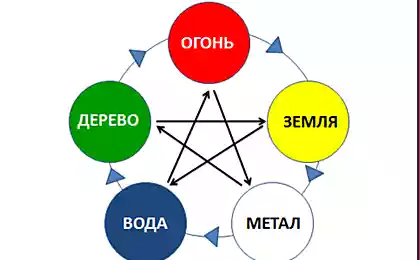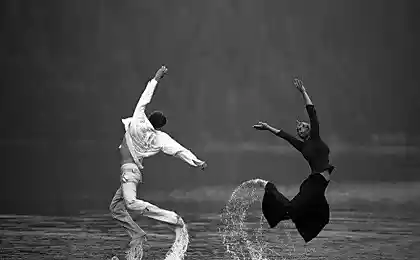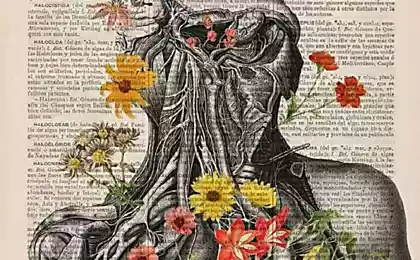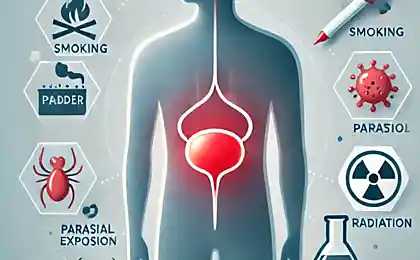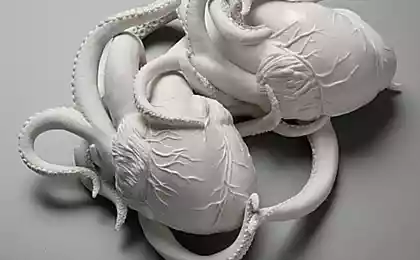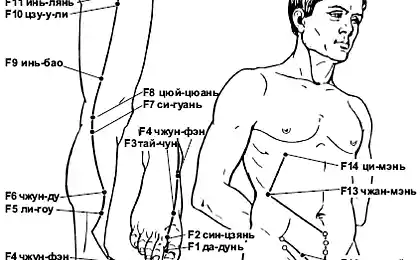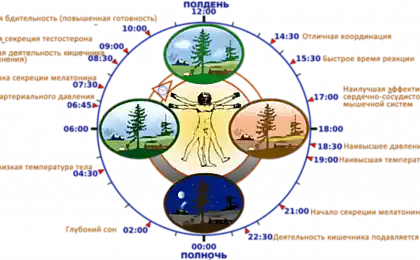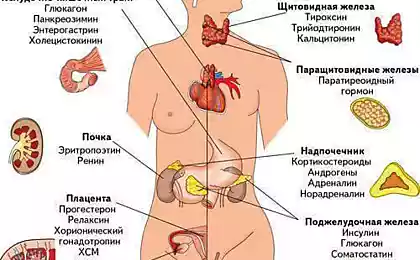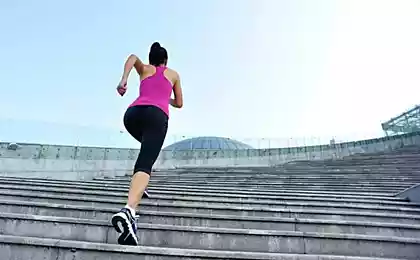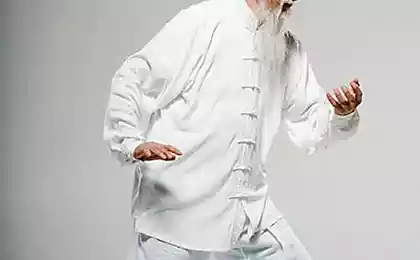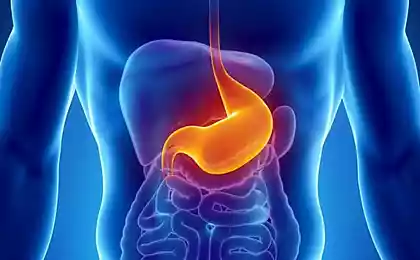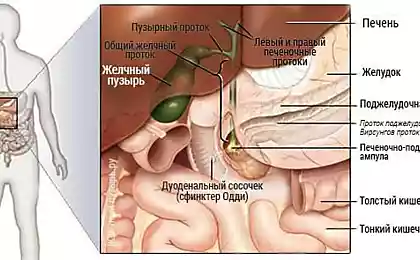508
Exercises for regulation of internal organs
The bladder Meridian on the foot TAYANA starts from the inner corner of the eye at the point sinmin (VI).
Lifting to his forehead and touching the medial end of the eyebrows at the point sangju (V 2), it connects with the Du Meridian at the vertex (top of head).

Following down, it reaches the point Tianzhu (V 10). Here, the Meridian divides into two branches. The internal branch reaches point dajue (VG 14).
Both branches (one is 2.5 CUN, and the other at 3 CUN from the spine) down along the spine down. In the kidneys of one of the branches enters into the abdominal cavity, where it joins with the kidneys, and on which the Meridian — bladder. Going further from the region of the kidneys, this branch was reunited with another branch in the popliteal fossa (back side of the feet behind the knee) to point Weijun (V 40).
Continuing downward along the posterior edge of the lateral surface of the tibia, Meridian reaches the lateral side of the tip of the little toe, where located the end point of the Meridian — Zhi-Yin (V 67).
At the point cgiing it connects with the Kidney Meridian on the foot — Saini.
Medical indications: Pain in the head, the neck, the lumbar and sacral region of the back and in the joints of the lower extremities, impotence, premature ejaculation, hemorrhoids, underdevelopment of the genitals.
Meridian is of particular importance to strengthen the kidneys, strengthen the Yang energy and regulate functioning of the bladder.
Since the bladder Meridian runs from head to toe, and the internal organs (Zang-fu) have their special point Shu in the back, it is the most important Meridian for the regulation of activities of the internal organs.
Requirements:
1. Performing the exercise, focus on the massage points of the head. While raising kidney Chi strain the muscles of the anus and genitals and stisnite teeth.
2. Clearly visualize the path of the Meridian: it divides into two branches at the point Tianzhu (V 10), where the inner branch should be to the point villas-chew (VG 14); then the two branches meet again in the popliteal fossa (behind the knee).
3. Remember the start and end points of the Meridian — sinmin (V 1) and jiin (V 67), and points sangju (V 2), Tianzhu (V 10), sanyu (V 23), Weijun (V 40) and cisi (V 52). You should also know point Shu in the back
4. If you are well versed in acupuncture and qigong, while you move qi, you should remember to keep in mind the order of all the Meridian points.
The location of the most important points of a Meridian of the bladder (Fig 161,162)


Sinmin (V 1) — 0.1 CUN above the inner corner of the eye. Sangju (V 2) — at the medial end of the eyebrow, on the supraorbital shaft. Tianzhu (V 10) — about 1.3 CUN away from the point Amani (VG 15) (see Fig. 325), behind the rear hair line, next to the trapezius muscle. Sanyu (V 23) — about 1.5 CUN to the side from the lower edge of the spinous process of the second lumbar vertebra. Weijun (V 40) is the middle of the transverse crease of the popliteal fossa. Kunlun (V 60) in the depression between the external malleolus and the heel tendon. Jiin (V 67) — on the lateral side of the little toe, about 0.1 CUN behind the corner of the nail.
Exercise:

1. Massage the point sinmin and sangju that your eyes sparkled, and her head was clear (Fig. 163, 164).
Massage 6 times point sinmin (V 1). Then massage 6 times point sangju (V 2). During the massage you should feel lighter boleznennye feeling. 2. go to the top, raise the qi to the brain and connect with ears (Fig. 165).

The arms are raised along the Meridian to the crown. Middle fingers to massage 6 times point baihui (VG 20). At the same time to visually imagine how the qi rises to the brain and connects with the ears.
3. Massage the point Tianzhu, to relax the muscles of neck and clean out the channel of the Meridian (Fig. 166). Push the point Tianzhu (V 10) 6 times. You can see a slight painful sensation and relaxation. This is done to relieve muscle tension in the head and clean out the channel of the Meridian.
4. Massage the skull and — in a circular motion — point dajue (Fig. 167, 168). Using the palms of your hands massage 6 times on the skull of the path between points sangju (V 2) and Tianzhu (V 10). Near the point Tianzhu, there are two branches. Internal cross point dajue (VG 14). Stimulate the point dajue rotation of the head — 6 times clockwise and 6 times counter-clockwise.

5. Stretch your hands and turn the palms down (Fig. 169). Breathing in, stretch your hands and turn them palms down. While exhaling, gradually bend and expand palms up.
6. Bend your arms, place hands on your back, straighten (Fig. 170). Bend your arms and place the back sides of the palms as high as possible on the back. Put thumbs and index fingers on both branches of the Meridian. Breathing in, slowly straighten your torso and slide your fingers down the Meridian.

7. Connect with the kidneys and raise your kidney qi (Fig. 171). When the fingers reach the point shenyu (V 23) and cisi (V 52) (see Fig. 161), the qi connects with the kidneys. At this time, tighten your abdominal muscles, reduce muscles around the genitals and anus and stisnite teeth. Do this 3 times. Breathing obychnoe.
8. Log into the bladder and up to the kidneys (Fig. 172). Move the hands from the kidneys to the bladder, where qi will enter into the bladder. Again tighten your abdominal muscles, reduce muscles around the genitals and anus and stisnite teeth. Do this 3 times. Breath normal.
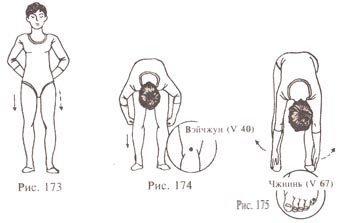
9. Follow down along the Meridian to the point jiin (Fig. 173, 174, 175). Hands are returned to the kidneys and move down along the Meridian to the popliteal fossa (behind the knee); there is a point Weijun (V 40), where both branches merge into one. Here hands promote qi along the Meridian to the endpoint jiin(67). Explanation. Promoting qi, do exhale and slowly bend.
10. Bend your knees and hold the qi (Fig. 176, 177). Straighten your body and raise your hands above your head.
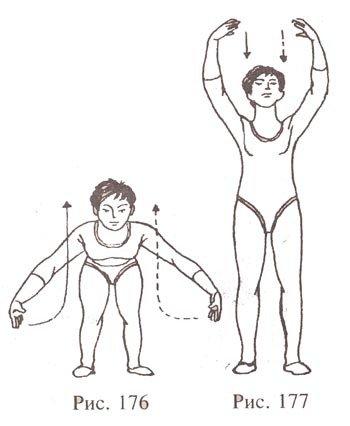
11. Repeat the movement 4, 5, 6, 7, 8, 9 (Fig. 178 — 182).

12. Scroll to the stop (Fig. 183, 184, 185).

When the qi reaches the point jiin (V 67), visually imagine how the qi is flowing to the feet and comes to points unchuan (R 1), where it connects with the Kidney Meridian on the foot — Saini.
published
P. S. And remember, just changing your mind — together we change the world! ©
Source: //yoga-home.ru/meridionalniy-tsygun/337-glava-3-vii-meridian-mochevogo-puzyrya-na-nogah-tayyan.html
Lifting to his forehead and touching the medial end of the eyebrows at the point sangju (V 2), it connects with the Du Meridian at the vertex (top of head).

Following down, it reaches the point Tianzhu (V 10). Here, the Meridian divides into two branches. The internal branch reaches point dajue (VG 14).
Both branches (one is 2.5 CUN, and the other at 3 CUN from the spine) down along the spine down. In the kidneys of one of the branches enters into the abdominal cavity, where it joins with the kidneys, and on which the Meridian — bladder. Going further from the region of the kidneys, this branch was reunited with another branch in the popliteal fossa (back side of the feet behind the knee) to point Weijun (V 40).
Continuing downward along the posterior edge of the lateral surface of the tibia, Meridian reaches the lateral side of the tip of the little toe, where located the end point of the Meridian — Zhi-Yin (V 67).
At the point cgiing it connects with the Kidney Meridian on the foot — Saini.
Medical indications: Pain in the head, the neck, the lumbar and sacral region of the back and in the joints of the lower extremities, impotence, premature ejaculation, hemorrhoids, underdevelopment of the genitals.
Meridian is of particular importance to strengthen the kidneys, strengthen the Yang energy and regulate functioning of the bladder.
Since the bladder Meridian runs from head to toe, and the internal organs (Zang-fu) have their special point Shu in the back, it is the most important Meridian for the regulation of activities of the internal organs.
Requirements:
1. Performing the exercise, focus on the massage points of the head. While raising kidney Chi strain the muscles of the anus and genitals and stisnite teeth.
2. Clearly visualize the path of the Meridian: it divides into two branches at the point Tianzhu (V 10), where the inner branch should be to the point villas-chew (VG 14); then the two branches meet again in the popliteal fossa (behind the knee).
3. Remember the start and end points of the Meridian — sinmin (V 1) and jiin (V 67), and points sangju (V 2), Tianzhu (V 10), sanyu (V 23), Weijun (V 40) and cisi (V 52). You should also know point Shu in the back
4. If you are well versed in acupuncture and qigong, while you move qi, you should remember to keep in mind the order of all the Meridian points.
The location of the most important points of a Meridian of the bladder (Fig 161,162)


Sinmin (V 1) — 0.1 CUN above the inner corner of the eye. Sangju (V 2) — at the medial end of the eyebrow, on the supraorbital shaft. Tianzhu (V 10) — about 1.3 CUN away from the point Amani (VG 15) (see Fig. 325), behind the rear hair line, next to the trapezius muscle. Sanyu (V 23) — about 1.5 CUN to the side from the lower edge of the spinous process of the second lumbar vertebra. Weijun (V 40) is the middle of the transverse crease of the popliteal fossa. Kunlun (V 60) in the depression between the external malleolus and the heel tendon. Jiin (V 67) — on the lateral side of the little toe, about 0.1 CUN behind the corner of the nail.
Exercise:

1. Massage the point sinmin and sangju that your eyes sparkled, and her head was clear (Fig. 163, 164).
Massage 6 times point sinmin (V 1). Then massage 6 times point sangju (V 2). During the massage you should feel lighter boleznennye feeling. 2. go to the top, raise the qi to the brain and connect with ears (Fig. 165).

The arms are raised along the Meridian to the crown. Middle fingers to massage 6 times point baihui (VG 20). At the same time to visually imagine how the qi rises to the brain and connects with the ears.
3. Massage the point Tianzhu, to relax the muscles of neck and clean out the channel of the Meridian (Fig. 166). Push the point Tianzhu (V 10) 6 times. You can see a slight painful sensation and relaxation. This is done to relieve muscle tension in the head and clean out the channel of the Meridian.
4. Massage the skull and — in a circular motion — point dajue (Fig. 167, 168). Using the palms of your hands massage 6 times on the skull of the path between points sangju (V 2) and Tianzhu (V 10). Near the point Tianzhu, there are two branches. Internal cross point dajue (VG 14). Stimulate the point dajue rotation of the head — 6 times clockwise and 6 times counter-clockwise.

5. Stretch your hands and turn the palms down (Fig. 169). Breathing in, stretch your hands and turn them palms down. While exhaling, gradually bend and expand palms up.
6. Bend your arms, place hands on your back, straighten (Fig. 170). Bend your arms and place the back sides of the palms as high as possible on the back. Put thumbs and index fingers on both branches of the Meridian. Breathing in, slowly straighten your torso and slide your fingers down the Meridian.

7. Connect with the kidneys and raise your kidney qi (Fig. 171). When the fingers reach the point shenyu (V 23) and cisi (V 52) (see Fig. 161), the qi connects with the kidneys. At this time, tighten your abdominal muscles, reduce muscles around the genitals and anus and stisnite teeth. Do this 3 times. Breathing obychnoe.
8. Log into the bladder and up to the kidneys (Fig. 172). Move the hands from the kidneys to the bladder, where qi will enter into the bladder. Again tighten your abdominal muscles, reduce muscles around the genitals and anus and stisnite teeth. Do this 3 times. Breath normal.

9. Follow down along the Meridian to the point jiin (Fig. 173, 174, 175). Hands are returned to the kidneys and move down along the Meridian to the popliteal fossa (behind the knee); there is a point Weijun (V 40), where both branches merge into one. Here hands promote qi along the Meridian to the endpoint jiin(67). Explanation. Promoting qi, do exhale and slowly bend.
10. Bend your knees and hold the qi (Fig. 176, 177). Straighten your body and raise your hands above your head.

11. Repeat the movement 4, 5, 6, 7, 8, 9 (Fig. 178 — 182).

12. Scroll to the stop (Fig. 183, 184, 185).

When the qi reaches the point jiin (V 67), visually imagine how the qi is flowing to the feet and comes to points unchuan (R 1), where it connects with the Kidney Meridian on the foot — Saini.
published
P. S. And remember, just changing your mind — together we change the world! ©
Source: //yoga-home.ru/meridionalniy-tsygun/337-glava-3-vii-meridian-mochevogo-puzyrya-na-nogah-tayyan.html
Brick, concrete or wood - how to choose a quality material for building a house
Why "usabilityinitiative"
